
Concept explainers
(a)
Interpretation:
The given compound is to be identified as
Concept introduction:
Heterocyclic compounds are defined as cyclic compounds which consist of at least one heteroatom, mostly nitrogen, sulfur, or oxygen. Heterocyclic compounds can be aromatic, antiaromatic, or nonaromatic. In some heterocyclic compounds, a noncarbon atom contributes to a p atomic orbital to the aromatic
Huckel’s
1) Aromatic if the number of electrons in that
Answer to Problem 14.20P
The given compound is antiaromatic.
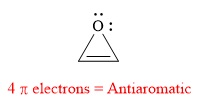
Explanation of Solution
The given compound is:

It is a heterocyclic compound with an oxygen atom. The hybridization of the oxygen atom must be

The total number of electrons in this
The given heterocyclic compound is antiaromatic if the total number of electrons in that
(b)
Interpretation:
The given compound is to be identified as aromatic, antiaromatic, or nonaromatic.
Concept introduction:
Heterocyclic compounds are defined as cyclic compounds which consists of at least one heteroatom mostly nitrogen, sulfur, or oxygen. Heterocyclic compounds can be aromatic, antiaromatic, or nonaromatic. In some heterocyclic compounds, a noncarbon atom contributes a p atomic orbital to the aromatic
Huckel’s rule for aromaticity states that if a species possesses a pi system of molecular orbitals constructed from p-orbitals that are fully conjugated around a ring (
1) Aromatic if the number of electrons in that
Answer to Problem 14.20P
The given compound is aromatic.
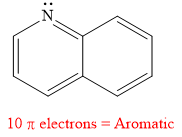
Explanation of Solution
The given compound is:
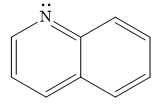
It is a heterocyclic compound with a nitrogen atom. The hybridization of the nitrogen atom must be

Thus, the total number of electrons in this
The given heterocyclic compound is aromatic if the number of electrons in that
(c)
Interpretation:
The given compound is to be identified as aromatic, antiaromatic, or nonaromatic.
Concept introduction:
Heterocyclic compounds are defined as cyclic compounds which consist of at least one heteroatom mostly nitrogen, sulfur, or oxygen. Heterocyclic compounds can be aromatic, antiaromatic, or nonaromatic. In some heterocyclic compounds, a noncarbon atom contributes a p atomic orbital to the aromatic
Huckel’s rule for aromaticity states that if a species possesses a pi system of molecular orbitals constructed from p-orbitals that are fully conjugated around a ring (
1) Aromatic if the number of electrons in that
Answer to Problem 14.20P
The given compound is nonaromatic.
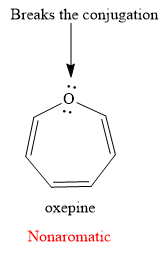
Explanation of Solution
The given compound is:
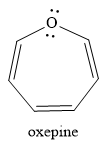
It is an oxygen containing a heterocycle consisting of a seven-membered ring with three double bonds. Due to geometrical constrains, the lone pairs of electrons on the oxygen atom are not in conjugation with the

If the molecule is assumed to be planar (flat), then too it would contain
The rule for aromaticity or antiaromaticity applies only if the system is planar, cyclic and has overlap of p-orbitals.
(d)
Interpretation:
The given compound is to be identified as aromatic, antiaromatic, or nonaromatic.
Concept introduction:
Heterocyclic compounds are defined as cyclic compounds which consists of at least one heteroatom mostly nitrogen, sulfur, or oxygen. Heterocyclic compounds can be aromatic, antiaromatic, or nonaromatic. In some heterocyclic compounds, a noncarbon atom contributes a p atomic orbital to the aromatic
Huckel’s rule for aromaticity states that if a species possesses a pi system of molecular orbitals constructed from p-orbitals that are fully conjugated around a ring (
1) Aromatic if the number of electrons in that
Answer to Problem 14.20P
The given compound is nonaromatic.
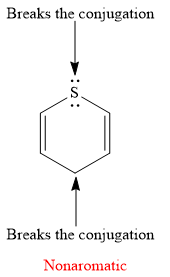
Explanation of Solution
The given compound is:

It is a sulfur containing a heterocycle consisting of a six-membered ring with two double bonds. There are two lone pair of electrons on the sulfur atom, but the sulfur atom is

As the
The rule for aromaticity or antiaromaticity applies only if the system is planar, cyclic and has overlap of p-orbitals.
(e)
Interpretation:
The given compound is to be identified as aromatic, antiaromatic, or nonaromatic.
Concept introduction:
Heterocyclic compounds are defined as cyclic compounds which consists of at least one heteroatom mostly nitrogen, sulfur, or oxygen. Heterocyclic compounds can be aromatic, antiaromatic, or nonaromatic. In some heterocyclic compounds, a noncarbon atom contributes a p atomic orbital to the aromatic
Huckel’s rule for aromaticity states that if a species possesses a pi system of molecular orbitals constructed from p-orbitals that are fully conjugated around a ring (
1) Aromatic if the number of electrons in that
Answer to Problem 14.20P
The given compound is nonaromatic.
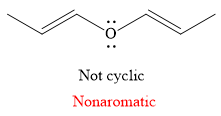
Explanation of Solution
The given compound is:

It is a straight chain compound with an oxygen atom and two double bonds. The above compound is not a cyclic compound. The rule for aromaticity or antiaromaticity applies only if the system is planar, cyclic and has overlap of p-orbitals. Thus, the

The rule for aromaticity or antiaromaticity applies only if the system is planar, cyclic and has overlap of p-orbitals.
(f)
Interpretation:
The given compound is to be identified as aromatic, antiaromatic, or nonaromatic.
Concept introduction:
Heterocyclic compounds are defined as cyclic compounds which consists of at least one heteroatom mostly nitrogen, sulfur, or oxygen. Heterocyclic compounds can be aromatic, antiaromatic, or nonaromatic. In some heterocyclic compounds, a noncarbon atom contributes a p atomic orbital to the aromatic
Huckel’s rule for aromaticity states that if a species possesses a pi system of molecular orbitals constructed from p-orbitals that are fully conjugated around a ring (
1) Aromatic if the number of electrons in that
Answer to Problem 14.20P
The given compound is aromatic.
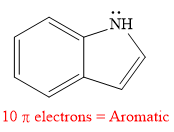
Explanation of Solution
The given compound is:

It is a heterocyclic compound with a nitrogen atom in which one six-membered and one five-membered rings are fused. The hybridization of the nitrogen atom is

Thus, the total number of electrons in this
The given heterocyclic compound is aromatic if the number of electrons in that
Want to see more full solutions like this?
Chapter 14 Solutions
EBK GET READY FOR ORGANIC CHEMISTRY
- Be sure to use wedge and dash bonds to show the stereochemistry of the products when it's important, for example to distinguish between two different major products. Predict the major products of the following reaction. Explanation Q F1 A Check F2 @ 2 # 3 + X 80 F3 W E S D $ 4 I O H. H₂ 2 R Pt % 05 LL ee F6 F5 T <6 G Click and drag to start drawing a structure. 27 & A 2025 McGraw Hill LLC. All Rights Reserved. Terms of Use Privacy Center Acce Y U H DII 8 9 F10 4 J K L Z X C V B N M T H option command F11 P H commandarrow_forwardCurved arrows are used to illustrate the flow of electrons. Use the reaction conditions provided and follow the arrows to draw the intermediate and product in this reaction or mechanistic step(s). Include all lone pairs and charges as appropriate. Ignore stereochemistry. Ignore inorganic byproducts. H :0: CH3 O: OH Q CH3OH2+ Draw Intermediate protonation CH3OH CH3OH nucleophilic addition H Draw Intermediate deprotonation :0: H3C CH3OH2* protonation H 0: H CH3 H.arrow_forwardPredicting the reactants or products of hemiacetal and acetal formation uentify the missing organic reactants in the following reaction: H+ X+Y OH H+ за Note: This chemical equation only focuses on the important organic molecules in the reaction. Additional inorganic or small-molecule reactants or products (like H2O) are not shown. In the drawing area below, draw the skeletal ("line") structures of the missing organic reactants X and Y. You may draw the structures in any arrangement that you like, so long as they aren't touching. Explanation Check Click and drag to start drawing a structure. ? olo 18 Ar © 2025 McGraw Hill LLC. All Rights Reserved. Terms of Use | Privacy Center | Accessibilityarrow_forward
- can someone please answer thisarrow_forwardPlease, please help me figure out the the moles, molarity and Ksp column. Step by step details because I've came up with about three different number and have no idea what I'm doing wrong.arrow_forwardwhat reagents are used to get this product from this reactant? Br OCH3arrow_forward
- can someone answer this pleasearrow_forwardcan someone do the reaction mechanism for this reaction and draw the molecules for Q2 and q3arrow_forwardIn this question, the product of the aldol condensation is shown. What would be the reactants for this product? Please provide a detailed explanation, as well as a drawing showing how the reactants will react to produce the product.arrow_forward
- 7. Propene undergoes a hydration reaction with water in the presence of an acid. a. There are two possible products for this reaction, both with the formula C,H,O. Show their structural formulas and names. (A1, B2) SCH4UR Name: (answer for part a. here!) VER 3 2021-2022 b. Which of the two products do you predict will form. Explain your choice using details from your learning. (B3)arrow_forwardWhat are the major products of the following organic reaction? Please include a detailed explanation as well as a drawing as to how the reaction proceeds.arrow_forwardWhat are the major products of the following reaction? Please provide a detailed explanation and a drawing to show how the reaction proceeds.arrow_forward
 Organic Chemistry: A Guided InquiryChemistryISBN:9780618974122Author:Andrei StraumanisPublisher:Cengage Learning
Organic Chemistry: A Guided InquiryChemistryISBN:9780618974122Author:Andrei StraumanisPublisher:Cengage Learning
